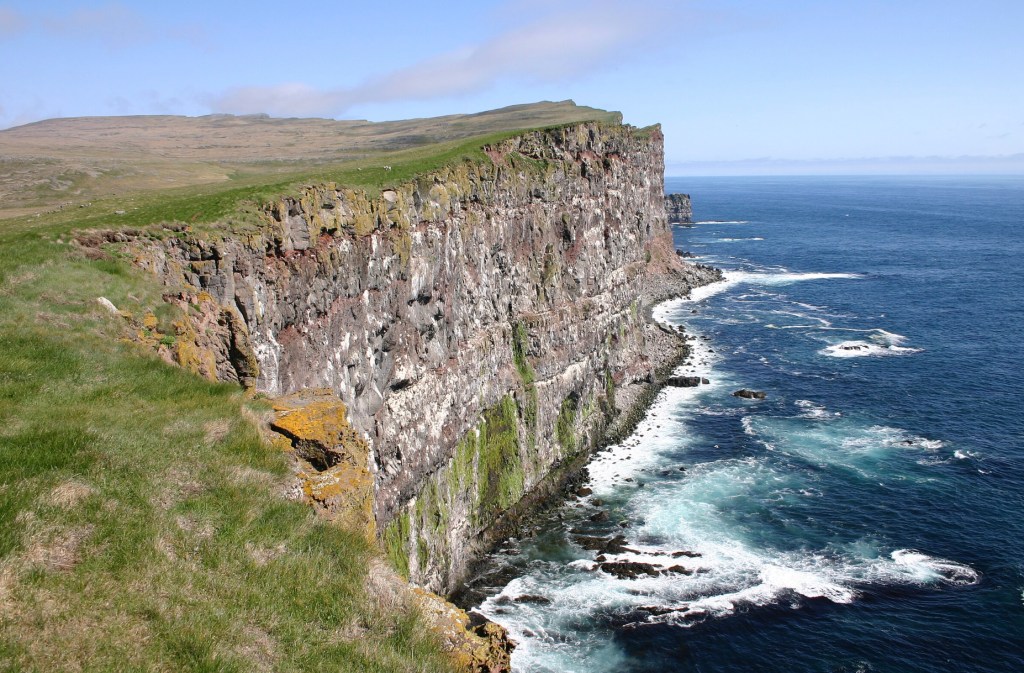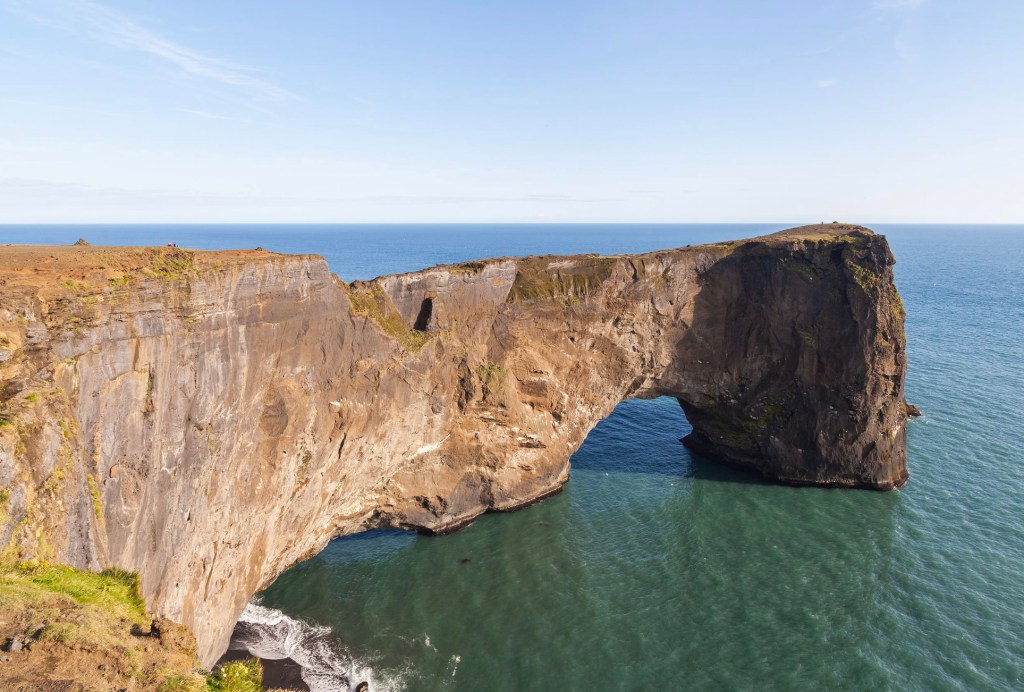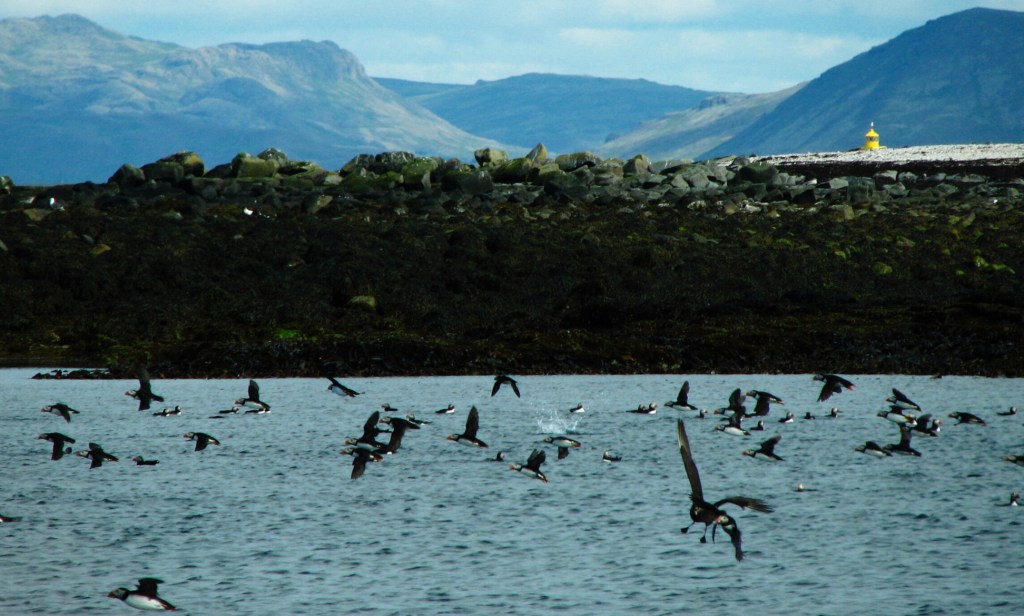


Get to know Iceland
Iceland hosts the world’s largest population of Atlantic puffins (Fratercula arctica), with more than 60% of the species gathering on its coastal cliffs during the summer breeding season. This concentration makes the country one of the major places to observe puffin nesting behavior, migration patterns, and colony structure.
Atlantic puffins nest in burrows and are adapted to nesting on stable cliff edges, diggable volcanic soil, and access to cold, fish-rich waters. Iceland provides all of these conditions, supporting large colonies that form from late spring to early summer on cliffs, offshore islands, and narrow headlands in consistent coastal clusters.
Key viewing areas include the western peninsulas, the southern islands, and several accessible sites near Reykjavík. These locations are suitable for campervan travel, as flexible routes can adjust to weather, light conditions, and daily colony activity, which strongly influence visibility.
Iceland hosts more than eight million Atlantic puffins during the breeding season, forming the world’s largest and most concentrated seabird population within a single national ecosystem.
Puffins nest in soft cliff soils, excavating burrows along elevated edges and forming dense colonies in regions such as the Westfjords and the South Coast.
Each summer, Atlantic puffins migrate along North Atlantic routes and return to established nesting sites across Iceland. From late May through July, daylight typically ranges from 18 to 21 hours per day, resulting in extended daylight that enhances feeding and breeding efficiency.
During this period, adult puffins form brightly colored keratin plates on their beaks, which are shed after they leave Iceland’s colonies at the end of summer. Pufflings remain in underground burrows for more than 40 days, protected by stable soil temperatures and shelter from maritime weather.
Icelandic puffins forage on coastal fish species, primarily sand eels and other small fish that thrive in the island’s cold, nutrient-rich waters. Many colonies are accessible from established viewing paths, allowing close observation without disrupting nesting behavior.
Puffins also hold cultural significance in Iceland, appearing in regional stories and wildlife-related tourism materials that associate the species with the country’s coastal environment.
In late April, puffins begin returning to Iceland as increasing daylight and warming coastal winds signal the start of their annual migration back from the North Atlantic. Early sightings appear along major cliff systems such as Látrabjarg and Dyrhólaey, where the first breeding pairs gather before larger colonies settle in May.
By early May, puffins in Iceland begin their breeding season as thousands of pairs establish territories along the cliffs. This period marks the transition from arrival flights to nesting activity, with heightened visibility along coastal edges as courtship displays and pair-bonding behaviors intensify.
From May through July, Icelandic puffins nest in extensive burrow systems carved into soft coastal soils, incubating their eggs deep within the cliffs of the Westfjords, South Coast, and offshore islands. Colony density increases steadily during this period as parents rotate incubation duties and maintain the underground chambers.
For travelers aligning wildlife viewing with broader seasonal planning, this mid-summer window also overlaps with the best time to visit Iceland, when long daylight hours and stable coastal weather enhance accessibility to major puffin habitats.
Between mid-June and mid-July, puffins in Iceland reach their peak visibility as nearly all breeding adults occupy the cliffs simultaneously. The long midsummer daylight hours amplify activity across nesting sites, making this four-week window the most reliable period for observing large, active colonies along the Westfjords, South Coast, and offshore islands.
From late July into early August, pufflings in Iceland develop within their underground burrows, remaining concealed while parents make frequent foraging trips along the coast. Only near the end of this period do some chicks approach the burrow entrances, though most stay out of sight until they fledge toward the open sea.
By late August, Iceland’s puffin colonies begin their departure as adults and fledglings leave the cliffs and return to the open sea. Shortening daylight and colder coastal winds initiate this final stage, leading to a rapid decline in colony activity across major nesting regions.
Atlantic puffins in Iceland occupy coastal habitats with suitable cliff edges, soft soils for burrow nesting, and direct access to open ocean waters. These conditions occur primarily along the island’s outer perimeter, leading to colonies forming on exposed coastlines and offshore islands rather than in inland terrain.
High-density colonies form on tall, erosion-shaped cliffs and isolated headlands where soil depth and uninterrupted flight access support stable breeding sites. This distribution produces consistent clustering in the country’s most rugged maritime areas.
Four major regions contain Iceland’s primary puffin habitats: the Westfjords, the South Coast, the Southern Islands, and the Capital Region.
The Westfjords contain some of Iceland’s most extensive puffin habitats, characterized by remote cliff systems with soft soils suitable for burrow nesting and minimal human disturbance. These conditions support some of the country’s highest colony densities, particularly along large headlands that provide uninterrupted access to open ocean waters.
Because the area is far from major transport routes, campervan travel is an efficient way to reach these outer cliffs and adjust viewing times based on weather and light conditions.

Látrabjarg Cliffs form the largest known puffin colony in Iceland, with steep, soft-soiled sea walls that allow dense burrow formation across accessible upper edges. The cliff’s geometry brings many birds into view, enabling precise observation of nesting patterns and flight activity.
The site’s isolation, combined with consistent ocean exposure and limited disturbance, produces exceptional colony density. Its distance from population centers makes flexible, self-driven campervan travel a practical way to reach the cliffs without relying on fixed transport schedules.
The South Coast of Iceland contains a long sequence of sea-facing cliffs and coastal headlands that support multiple puffin nesting sites. Colonies here tend to form in smaller, concentrated groups compared with the larger aggregations in the Westfjords, but the region’s terrain brings many burrows close to accessible viewing points. Soft upper soils, direct ocean access, and consistent cliff exposure create suitable nesting conditions along much of the coastline.
Because the South Coast is directly connected to the Ring Road, it is easy to reach and well-suited to flexible, self-guided travel such as campervan routes.

Dyrhólaey is one of the South Coast’s primary puffin habitats, with steep sea cliffs and soft upper soils that allow burrows to form close to the cliff edge. This layout enables clear, short-distance observation throughout the nesting season. Portions of the promontory close from mid-May to late June to protect active breeding sites.
The headland is accessible by road from the Ring Road, making it a practical stop for visitors traveling by campervan along the South Coast.
The South Islands, centered on the Westman Islands archipelago, contain several offshore puffin habitats where volcanic slopes and low-disturbance terrain support very dense nesting colonies. These island ecosystems hold a significant share of Iceland’s puffin population and differ ecologically from mainland cliff zones because of their isolation and uniform volcanic soil.
Access requires a short ferry crossing, but departure points along the South Coast are easily reached by campervan, providing straightforward transit to Heimaey, the main puffin site in the archipelago.

Heimaey Island hosts Iceland’s largest puffin colony across volcanic hillsides, grassy nesting areas, and steep coastal cliffs that offer extensive burrow-suitable soil. Puffins nest along walkable elevations and near cliff-edge paths, enabling close but controlled observation during the breeding season.
The island is reached by ferry from South Coast ports accessible by campervan, forming a key offshore nesting hub within Iceland’s broader puffin distribution.
The Capital Region on Iceland’s southwest coast offers accessible puffin viewing near Reykjavík, where small seasonal colonies gather on nearby offshore islets rather than on the mainland. These low-density groups are visible during the summer nesting period from coastal pullouts and harbor viewpoints, providing short-distance observation without major route changes.
Because these sites are close to the Ring Road and urban roads, campervan travelers can incorporate brief wildlife stops while moving through Reykjavík or transitioning between regions. Lundey is the primary puffin site within this area.

Lundey, or Puffin Island, is an uninhabited offshore islet northeast of Reykjavík that hosts moderate seasonal puffin colonies from May through August. The island is not accessible for on-foot visitation, but its nesting activity is observable from mainland viewpoints due to its proximity to the coastline. This makes Lundey an urban-adjacent puffin habitat where campervan travelers can use harbor areas or marked coastal pullouts to view offshore nesting behavior during the breeding season.
Puffin watching in Iceland generally follows two distinct approaches: structured puffin tours that deliver guided, fixed-schedule access to selected colonies, and self-directed campervan travel that enables flexible timing, broader regional coverage, and independent movement between nesting sites.
Tour-based puffin viewing provides access to select nesting areas but operates within fixed time slots and region-specific routes, which limit the ability to adjust observation windows to shifting weather, light conditions, or colony activity. Because group pacing governs how long each site can be observed, tours typically prioritize efficient movement over extended wildlife encounters.
Self-guided puffin observation by campervan allows access to multiple regions and nesting habitats, adapting naturally to shifting daylight angles, changing sea conditions, and colony rhythms such as dawn return flights or evening gatherings. Because travel schedules are self-determined, observation periods can be extended at cliffside colonies, offering more time for low-impact wildlife watching than fixed-schedule tours typically afford.
Responsible puffin watching in Iceland begins with understanding that these seabirds rely on fragile cliffside burrows and tightly timed breeding cycles, making their nesting grounds highly sensitive to sound, movement, and proximity throughout the May–August season.
Excessive proximity, off-path movement, and elevated noise levels disrupt puffin behavior by stressing breeding adults and destabilizing the soil around their burrows, whereas maintaining distance, staying on marked routes, and minimizing sound preserve nesting safety and support calmer, more observable colony activity.
Artificial light, concentrated group movement, and poorly timed activity amplify disturbance during the peak nesting window, as bright flashes interrupt natural behavior and dense human presence alters feeding patterns. At the same time, low-light, low-movement conditions preserve longer, more authentic viewing opportunities.
Because flexible scheduling allows arrival during quieter periods of the day, campervan-based travel aligns naturally with low-impact puffin watching, reducing crowd-driven disturbance and supporting longer, calmer observation that preserves the birds’ natural behavior.
Preparing for puffin watching in Iceland means equipping yourself for habitats that range from exposed cliffs to offshore islets, where shifting weather, variable distances, and uneven coastal terrain shape the conditions under which puffins can be observed.
Because Icelandic puffin sites are strongly influenced by maritime weather patterns, weather-adaptive clothing layers are essential: windproof shells, waterproof outerwear, and warm base layers protect against cold sea winds and sudden rain that frequently sweep across cliffside environments such as the Westfjords and the South Coast. Durable hiking boots with strong grip support movement across wet grass, uneven rock, or sloping coastal ground, especially in high-exposure areas where burrow openings line the paths and require careful footing.
Puffin colonies often nest along cliff edges or at distances that place them slightly beyond the naked eye, making long-range optics a critical component of responsible observation. Binoculars or spotting scopes enhance viewing clarity at high vantage points such as Látrabjarg, while telephoto lenses and stable supports help document natural behavior without approaching sensitive burrow areas. Quiet, non-reflective gear also reduces disturbance, allowing observation that aligns with puffin breeding rhythms and preserves calm colony dynamics.
Self-guided mobility across remote promontories or island-access points also benefits from navigation tools and day-long essentials. Compact backpacks, water, and energy-dense snacks sustain long cliffside sessions, while offline maps or GPS systems help maintain orientation in regions where connectivity fades. Red-light filters or low-intensity lamps support ethical movement during low-light periods, reducing disturbance in burrow zones where nocturnal puffling activity may occur.
Campervan-supported travel is a mobile base for this equipment, providing sheltered storage for optics and outerwear, space for wet-gear drying, and flexible staging when shifting between multiple puffin habitats in a single day. This readiness enhances both comfort and observational quality, especially when adjusting to weather windows at coastal cliffs or timing a return to offshore vantage points near urban or rural harbors.

CampEasy Opening hours 09:00-16:00
Learn more about Self-Service
A minimum of 20 hours notice is required to use the booking engine. Click here to contact us directly for a booking less than 20 hours from now.
Change Date